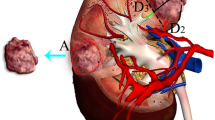Abstract
Purpose
The RENAL nephrometry score (RNS) was developed to quantify complexity of renal tumors in a reproducible manner. We aim to determine whether individual categories of the RNS have different impact on the warm ischemia time (WIT) for patients undergoing robotic partial nephrectomy (RPN).
Methods
In a retrospective analysis of a prospectively maintained database, we identified 251 consecutive patients who underwent RPN between January 2007 and June 2010. RNS was determined in 187 with available imaging. Univariable analysis and multivariable linear regression analysis were performed to identify which factors were more significantly associated with WIT.
Results
Overall RNS was of low (4–6), moderate (7–9), and high complexity (10–12) in 84 (45 %), 80 (43 %), and 23 (12 %) patients, respectively. There was no association between gender (p = 0.6), BMI (p = 0.3), or anterior/posterior location (A) (p = 0.8), and WIT. On univariable analysis, longer WIT was associated with size (R) >4 cm (p < 0.0001), entirely endophytic properties (E) (p = 0.005), tumor <4 mm from the collecting system/sinus (N) (p < 0.0001), and location between the polar lines (L) (p = 0.004). Total RNS and WIT were highly correlated (Spearman correlation coefficient = 0.54, p < 0.0001). There was a significant trend of higher WIT with increased tumor complexity (p for trend <0.0001). After multivariable analysis, only R (p = 0.0003), E (p = 0.003), and N (p = 0.00002) components of the RNS were significantly associated with WIT.
Conclusions
The A and L subcategories of the RNS have no significant impact on the WIT of patients undergoing RPN. WIT is significantly dependent upon the other subcategories, as well as the overall RNS. These findings can be used to preoperatively predict which tumor characteristics will likely affect WIT and may be useful in preoperative counseling as well as planning of approach.
Similar content being viewed by others
Abbreviations
- RNS:
-
RENAL nephrometry
- WIT:
-
Warm ischemia time
- BMI:
-
Body mass index
- RPN:
-
Robotic partial nephrectomy
- GFR:
-
Glomerular filtration rate
References
Rini BI, Campbell SC, Escudier B (2009) Renal cell carcinoma. Lancet 373:1119–1132
Novick AC, Campbell SC, Belldegrun A et al. (2009) American Urological Association guideline for management of the clinical stage 1 renal mass. Panel consensus regarding treatment modalities. http://www.auanet.org/content/guidelines-and-quality-care/clinical-guidelines/main-reports/renalmass09.pdf. Accessed on 29 Sept 2011
Ljungberg B, Cowan NC, Hanbury DC et al (2010) EAU guidelines on renal cell carcinoma: the 2010 update. Eur Urol 58:398–406
Go AS, Chertow GM, Fan D, McCulloch CE, Hsu CY (2004) Chronic kidney disease and the risks of death, cardiovascular events, and hospitalization. N Engl J Med 351:1296–1305
Weight CJ, Larson BT, Gao T et al (2010) Elective partial nephrectomy in patients with clinical T1b renal tumors is associated with improved overall survival. Urology 76:631–638
Thompson RH, Lane BR, Lohse CM et al (2010) Every minute counts when the renal hilum is clamped during partial nephrectomy. Eur Urol 58:340–345
Lane BR, Babineau DC, Poggio ED, Weight CJ, Larson BT, Gill IS, Novick AC (2008) Factors predicting renal functional outcome after partial nephrectomy. J Urol 180:2263–2269
Kutikov A, Uzzo RG (2009) The RENAL nephrometry score: a comprehensive standardized system for quantitating renal tumor size, location and depth. J Urol 182:844–853
Becker F, Van Poppel H, Hakenberg OW et al (2009) Assessing the impact of ischaemia time during partial nephrectomy. Eur Urol 56:625–635
Sorbellini M, Kattan MW, Snyder ME, Hakimi AA, Sarasohn DM, Russo P (2006) Prognostic nomogram for renal insufficiency after radical or partial nephrectomy. J Urol 176:472–476
Lane BR, Russo P, Uzzo RG, Hernandez AV, Boorjian SA, Thompson RH, Fergany AF, Love TE, Campbell SC (2011) Comparison of cold and warm ischemia during partial nephrectomy in 660 solitary kidneys reveals predominant role of nonmodifiable factors in determining ultimate renal function. J Urol 185:421–427
Simmons MN, Fergany AF, Campbell SC (2011) Effect of parenchymal volume preservation on kidney function after partial nephrectomy. J Urol 186:405–410
Ficarra V, Novara G, Secco S (2009) Preoperative aspects and dimensions used for an anatomical (PADUA) classification of renal tumours in patients who are candidates for nephron-sparing surgery. Eur Urol 56:786–793
Simmons MN, Ching CB, Samplaski MK, Park CH, Gill IS (2010) Kidney tumor location measurement using the C index method. J Urol 183:1708–1713
Bruner B, Breau RH, Lohse CM, Leibovich BC, Blute ML (2011) Renal nephrometry score is associated with urine leak after partial nephrectomy. BJU Int 108:67–72
Hayn MH, Schwaab T, Underwood W, Kim HL (2011) RENAL nephrometry score predicts surgical outcomes of laparoscopic partial nephrectomy. BJU Int 108:876–881
Kutikov A, Smaldone MC, Egleston BL, Manley BJ, Canter DJ, Simhan J, Boorjian SA, Viterbo R, Chen DY, Greenberg RE, Uzzo RG (2011) Anatomic features of enhancing renal masses predict malignant and high-grade pathology: a preoperative nomogram using the RENAL Nephrometry score. Eur Urol 60:241–248
Mottrie A, Schatteman P, De Wil P, De Troyer B, Novara G, Ficarra V (2011) Validation of the preoperative aspects and dimensions used for an anatomical (PADUA) score in a robot-assisted partial nephrectomy series. World J Urol. doi:10.1007/s00345-010-0639-y
Samplaski MK, Hernandez AV, Gill IS, Simmons MN (2010) C-index is associated with functional outcomes after laparoscopic partial nephrectomy. J Urol 184:2259–2263
Okhunov Z, Rais-Bahrami S, George AK, Waingankar N, Duty B, Montag S, Rosen L, Sunday S, Vira MA, Kavoussi LR (2011) The comparison of three renal tumor scoring systems: C-index, PADUA, and RENAL nephrometry scores. J Endourol. doi:10.1089/end.2011.0301
Conflict of interest
Dr. Jihad H. Kaouk and Dr. Georges-Pascal Haber are consultant for Intuitive Surgical. This study was not sponsored.
Author information
Authors and Affiliations
Corresponding author
Rights and permissions
About this article
Cite this article
Altunrende, F., Laydner, H., Hernandez, A.V. et al. Correlation of the RENAL nephrometry score with warm ischemia time after robotic partial nephrectomy. World J Urol 31, 1165–1169 (2013). https://doi.org/10.1007/s00345-012-0867-4
Received:
Accepted:
Published:
Issue Date:
DOI: https://doi.org/10.1007/s00345-012-0867-4




